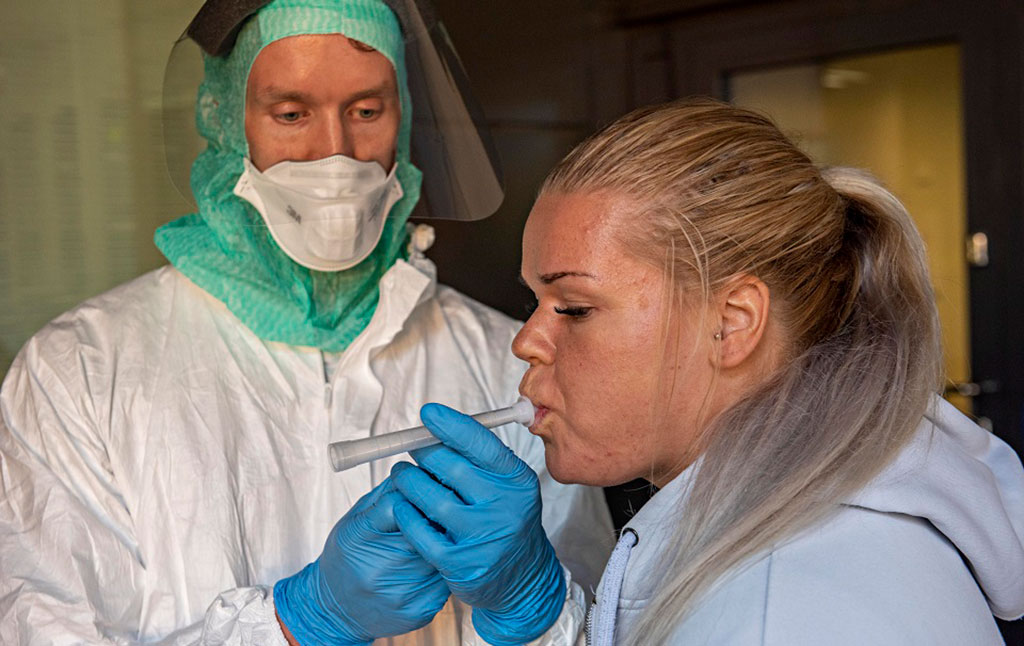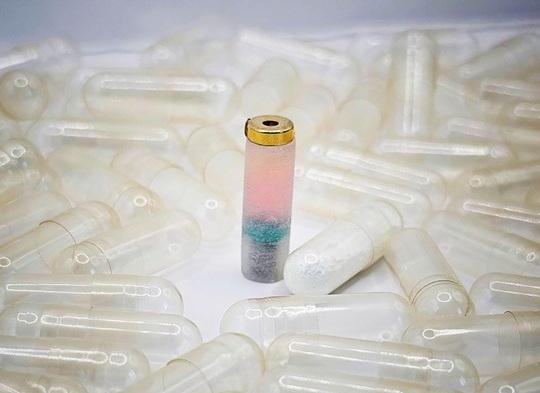Non-Invasive COVID-19 Test Identifies `Breath Signatures` to Provide Almost Instant Results
|
By HospiMedica International staff writers Posted on 29 Oct 2020 |

Image: The BreathSpec device was used during field trials last year in Finland (Photo courtesy of Andrew Weekes)
Initial findings from a new study have shown how COVID-19 can be detected via a non-invasive breath test by identifying candidate biomarkers, providing almost instant results.
The new study was conducted by Loughborough University (Leicestershire, UK) which is part of a consortium’s research team that has been able to identify candidate biomarkers present in the breath of someone affected by COVID-19. Utilizing technologies which were developed earlier, the team has demonstrated how these markers or ‘breath signatures’ can be used to rapidly distinguish COVID-19 from other respiratory conditions at point of need, such as an emergency department, a workplace or a care setting, with no laboratory support. The IMSPEX Group which is also part of the consortium will be working alongside researchers to help develop and scale such technology. Its BreathSpec device has been a key tool used by researchers in the analysis of volatile organic compounds (VOCs) in human breath.
For the feasibility study, the researchers recruited 98 patients, out of whom 31 had COVID-19. Other diagnoses included asthma, exacerbation of asthma and COPD, viral pneumonia, other respiratory tract infections, and cardiac conditions. In order to identify and diagnose COVID-19 from the samples, the team used Gas Chromatography (GC) - a procedure used for separating and analyzing compounds that can be vaporized without decomposition - and Ion Mobility Spectrometry (IMS) – an analytical technique used to separate and identify ionized molecules in the gas phase. The study participants gave a single breath-sample for the analysis of VOCs by GC-IMS. The analysis identified aldehydes (ethanal, octanal), ketones (acetone, butanone), and methanol that discriminated COVID-19 from other conditions.
“We are hugely encouraged by these findings. Employing tried and tested techniques used during the TOXI-Triage project, suggests that COVID-19 may be rapidly distinguished from other respiratory conditions,” said Paul Thomas, Professor of Analytical Science from Loughborough’s Department of Chemistry. “To develop this technique further larger studies are required, together with complementary GC-MS studies, to build on the data collected so far. If shown to be reliable, it offers the possibility for rapid identification or exclusion of COVID-19 in emergency departments or primary care that will protect healthcare staff, improve the management of patients and reduce the spread of COVID-19.”
Related Links:
Loughborough University
The new study was conducted by Loughborough University (Leicestershire, UK) which is part of a consortium’s research team that has been able to identify candidate biomarkers present in the breath of someone affected by COVID-19. Utilizing technologies which were developed earlier, the team has demonstrated how these markers or ‘breath signatures’ can be used to rapidly distinguish COVID-19 from other respiratory conditions at point of need, such as an emergency department, a workplace or a care setting, with no laboratory support. The IMSPEX Group which is also part of the consortium will be working alongside researchers to help develop and scale such technology. Its BreathSpec device has been a key tool used by researchers in the analysis of volatile organic compounds (VOCs) in human breath.
For the feasibility study, the researchers recruited 98 patients, out of whom 31 had COVID-19. Other diagnoses included asthma, exacerbation of asthma and COPD, viral pneumonia, other respiratory tract infections, and cardiac conditions. In order to identify and diagnose COVID-19 from the samples, the team used Gas Chromatography (GC) - a procedure used for separating and analyzing compounds that can be vaporized without decomposition - and Ion Mobility Spectrometry (IMS) – an analytical technique used to separate and identify ionized molecules in the gas phase. The study participants gave a single breath-sample for the analysis of VOCs by GC-IMS. The analysis identified aldehydes (ethanal, octanal), ketones (acetone, butanone), and methanol that discriminated COVID-19 from other conditions.
“We are hugely encouraged by these findings. Employing tried and tested techniques used during the TOXI-Triage project, suggests that COVID-19 may be rapidly distinguished from other respiratory conditions,” said Paul Thomas, Professor of Analytical Science from Loughborough’s Department of Chemistry. “To develop this technique further larger studies are required, together with complementary GC-MS studies, to build on the data collected so far. If shown to be reliable, it offers the possibility for rapid identification or exclusion of COVID-19 in emergency departments or primary care that will protect healthcare staff, improve the management of patients and reduce the spread of COVID-19.”
Related Links:
Loughborough University
Latest COVID-19 News
- Low-Cost System Detects SARS-CoV-2 Virus in Hospital Air Using High-Tech Bubbles
- World's First Inhalable COVID-19 Vaccine Approved in China
- COVID-19 Vaccine Patch Fights SARS-CoV-2 Variants Better than Needles
- Blood Viscosity Testing Can Predict Risk of Death in Hospitalized COVID-19 Patients
- ‘Covid Computer’ Uses AI to Detect COVID-19 from Chest CT Scans
- MRI Lung-Imaging Technique Shows Cause of Long-COVID Symptoms
- Chest CT Scans of COVID-19 Patients Could Help Distinguish Between SARS-CoV-2 Variants
- Specialized MRI Detects Lung Abnormalities in Non-Hospitalized Long COVID Patients
- AI Algorithm Identifies Hospitalized Patients at Highest Risk of Dying From COVID-19
- Sweat Sensor Detects Key Biomarkers That Provide Early Warning of COVID-19 and Flu
- Study Assesses Impact of COVID-19 on Ventilation/Perfusion Scintigraphy
- CT Imaging Study Finds Vaccination Reduces Risk of COVID-19 Associated Pulmonary Embolism
- Third Day in Hospital a ‘Tipping Point’ in Severity of COVID-19 Pneumonia
- Longer Interval Between COVID-19 Vaccines Generates Up to Nine Times as Many Antibodies
- AI Model for Monitoring COVID-19 Predicts Mortality Within First 30 Days of Admission
- AI Predicts COVID Prognosis at Near-Expert Level Based Off CT Scans
Channels
Critical Care
view channel
AI Heart Attack Risk Assessment Tool Outperforms Existing Methods
For decades, doctors have relied on standardized scoring systems to assess patients with the most common type of heart attack—non-ST-elevation acute coronary syndrome (NSTE-ACS). The GRACE score, used... Read more
'Universal' Kidney to Match Any Blood Type
Blood-type incompatibility has long been one of the greatest obstacles in organ transplantation, forcing thousands of patients—particularly those with type O blood—to wait years longer for compatible donors.... Read moreSurgical Techniques
view channel
Minimally Invasive Endoscopic Surgery Improves Severe Stroke Outcomes
Intracerebral hemorrhage, a type of stroke caused by bleeding deep within the brain, remains one of the most challenging neurological emergencies to treat. Accounting for about 15% of all strokes, it carries... Read more
Novel Glue Prevents Complications After Breast Cancer Surgery
Seroma and prolonged lymphorrhea are among the most common complications following axillary lymphadenectomy in breast cancer patients. These postoperative issues can delay recovery and postpone the start... Read morePatient Care
view channel
Revolutionary Automatic IV-Line Flushing Device to Enhance Infusion Care
More than 80% of in-hospital patients receive intravenous (IV) therapy. Every dose of IV medicine delivered in a small volume (<250 mL) infusion bag should be followed by subsequent flushing to ensure... Read more
VR Training Tool Combats Contamination of Portable Medical Equipment
Healthcare-associated infections (HAIs) impact one in every 31 patients, cause nearly 100,000 deaths each year, and cost USD 28.4 billion in direct medical expenses. Notably, up to 75% of these infections... Read more
Portable Biosensor Platform to Reduce Hospital-Acquired Infections
Approximately 4 million patients in the European Union acquire healthcare-associated infections (HAIs) or nosocomial infections each year, with around 37,000 deaths directly resulting from these infections,... Read moreFirst-Of-Its-Kind Portable Germicidal Light Technology Disinfects High-Touch Clinical Surfaces in Seconds
Reducing healthcare-acquired infections (HAIs) remains a pressing issue within global healthcare systems. In the United States alone, 1.7 million patients contract HAIs annually, leading to approximately... Read moreHealth IT
view channel
Printable Molecule-Selective Nanoparticles Enable Mass Production of Wearable Biosensors
The future of medicine is likely to focus on the personalization of healthcare—understanding exactly what an individual requires and delivering the appropriate combination of nutrients, metabolites, and... Read moreBusiness
view channel
Philips and Masimo Partner to Advance Patient Monitoring Measurement Technologies
Royal Philips (Amsterdam, Netherlands) and Masimo (Irvine, California, USA) have renewed their multi-year strategic collaboration, combining Philips’ expertise in patient monitoring with Masimo’s noninvasive... Read more
B. Braun Acquires Digital Microsurgery Company True Digital Surgery
The high-end microsurgery market in neurosurgery, spine, and ENT is undergoing a significant transformation. Traditional analog microscopes are giving way to digital exoscopes, which provide improved visualization,... Read more
CMEF 2025 to Promote Holistic and High-Quality Development of Medical and Health Industry
The 92nd China International Medical Equipment Fair (CMEF 2025) Autumn Exhibition is scheduled to be held from September 26 to 29 at the China Import and Export Fair Complex (Canton Fair Complex) in Guangzhou.... Read more

















